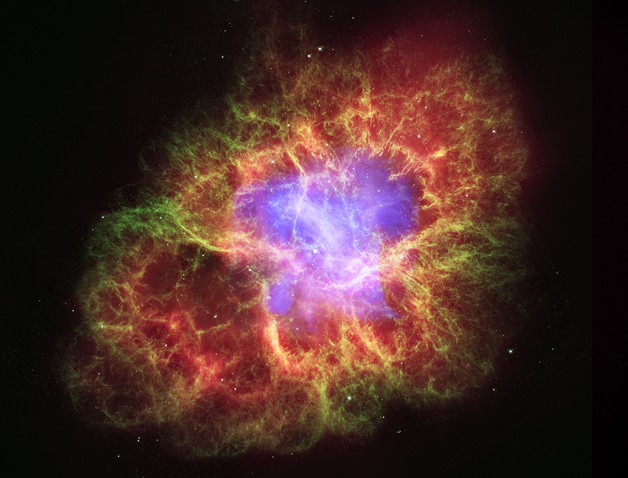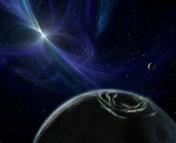Authors: Hirai, Ryosuke and Podsiadlowski, Philipp
First Author’s Institution: School of Physics and Astronomy, Monash University, VIC 3800, Australia
Status: Published in MNRAS Journal [open access]
Picture this: you are smack-dab at the barycentre of a peaceful stellar binary, when suddenly one of its members — the primary– erupts into a supernova. For years you had watched its companion –the secondary– slowly siphon off the primary’s outer layers, devouring it piecemeal. But now, that primary star has erupted into a stripped-envelope core-collapse supernova (CCSN), giving rise to a newborn neutron star (NS).
Like humans, supernovae are not perfect or symmetrical. Instead, their asymmetry causes a “kick,” or a net velocity different from its previous orbital velocity. With this natal kick, the newborn neutron star flies whizzing past your head, barreling towards the companion star! In today’s paper, the authors consider what happens when the NS approaches its main-sequence (MS) companion and what we would observe back on Earth.
The Setting
With a predicted 70% of CCSNe in binaries with a MS companion, it’s no wonder we find ourselves in the current situation. However, our odds change considerably when we consider whether or not the kick of the newborn NS is well aligned to collide with the companion star, like a game of darts on an astronomical scale. Today’s authors estimate about 1% of systems will have a tight enough orbit where a collision is possible. 1% may not seem like good odds, but the authors offer a glimmer of hope. They also point out that 1/3 of the core-collapse population are also stripped-envelope supernovae. If their stripping is caused by a binary companion, rather than a mechanism internal to the dying star, then the possibility of them being close enough to interact or collide could be greater.
The authors examine events that occur over a small angle of supernova kicks, such that the new NS comes into close contact with its companion. Stars are not solid billiard balls in space— they are spheres of gas with dense cores. A “collision,” therefore, is not between two hard surfaces; it instead alludes to a range of broader interpretations. This creates three exciting scenarios when the companion mass is larger than the mass of the NS: (i) a direct collision between the NS and the core of the companion star (ii) a near-miss of the core, wherein the NS slogs through the star’s outer layers, and (iii) a NS plunge through the outer layers of the companion, potentially slingshotting the companion to “hypervelocity” speeds, or thieving material to create its own planets.
To assess these potential outcomes, the authors developed 3D hydrodynamical simulations of newborn neutron stars and their MS binary companions, diverting extra attention to the drag force the NS experiences when inside the dense gas of the star. From this, they construct a semi-analytic formula to apply over a range of different kick velocities and angles for the moment of neutron star creation. Let’s explore each of the outcomes in detail.
Direct Collision
Perhaps upon reading a recent AstroBite you’ve come to love and appreciate the strange cosmic beasts called Thorne-Żytkow Objects (TŻOs). If not, TŻOs are stars with a neutron star core and a large encompassing envelope, masquerading as a run-of-the-mill red supergiant. Remarkably, these objects are stable (as opposed to further collapse into a black hole) and they can survive millions of years.
The binary analyzed in today’s paper has all the right ingredients: a neutron star, a main-sequence star, and a crash-course headed near the star’s center. If the impact of the incoming NS is not too extreme (meaning it can be captured in a stable orbit about the MS star’s core), the gravitational drag of the companion star decelerates the NS until they merge. The energy dissipated from the decaying orbit of the NS ripples through the outer envelope of the MS star as shocks that cause the star to rapidly expand, therefore completing the TŻO picture. A few frames of the simulation of today’s paper are presented in Figure 1, where these steps are illustrated.
Figure 1: A TŻO forms when the newborn NS is captured in the MS star’s envelope and merges with its core. (Fig 1 in today’s paper, annotations added by AstroBite author.)
Intermediate Case
What happens if the NS doesn’t hit a perfect bullseye (at the core of the MS star), but also doesn’t make a perfect getaway? In this case, the NS is trapped in a new orbit with the companion— one that will produce recurrent plunges into its atmosphere before they eventually collide at the core. The NS will drag material that it accretes directly onto its surface, producing outflows or jets. Because this NS was just born in a supernova, the outflow can illuminate the explosion from the inside in a dazzling display that revitalizes the light curve observed on Earth.
As the NS slows down each time it passes through the companion’s envelope, the dragging, accretion, and flaring can reoccur several times, refueling the light curve in similar ways. The authors posit that this could explain bumps and wiggles in late-time observations of superluminous supernovae (a mystery covered in a previous Bite)! Eventually, the NS will circle-in on the companion’s core, merging and also creating a TŻO.
Turning Up the Dial
If the companion star is unable to fully capture the NS, it is possible for the NS to plunge through the MS star’s atmosphere, re-emerge on the other side, and drag away material. As the NS makes its escape, the trailing debris can form an accretion disk (Figure 2). From the inner layers of the disk the NS can feed quickly enough after its original SN explosion that added bumps are visible in its light curve on Earth.
Meanwhile, the outer rings of the stolen disk are more stable and allowed to cool, perhaps even to the point of forming protoplanetary disks and eventually planets. The authors turn our attention to the fact that the first exoplanets discovered were around pulsars, and their origins still have yet to be explained. Other theories include a capture of planets by the NS or that the NS evaporated the original star at the center of the system.
Figure 2: A NS rockets through the envelope of its companion, escaping its clutches and stealing material that forms a disk around it. (Fig 1 in today’s paper, annotations added by AstroBite author.)
Astronomers look to multiple characteristics of a system to piece together the full story. One of these clues in pulsar exoplanetary systems is eccentricity of planets’ orbits. Over a long period of time, orbits that were once eccentric become more circular. PSR B1257+12 is one such NS planetary system, hosting three planets with very circular orbits, indicating they likely formed in a protoplanetary disk over a long period of time.
In the event that the neutron star’s kick is faster than the escape velocity of the companion star, the NS’s travel near the core can also accelerate the secondary, much like the way we use Mars to slingshot spacecraft farther than is possible with fuel alone. The authors posit this scenario as an explanation for observed hypervelocity stars, or stars that move unusually fast through their surroundings. In fact, their models conclude that stars can travel up to 600 km/s, 10% greater than their originally conceived limit!
As binaries are very common in the natural universe, it comes down to a matter of mass and aim for any of these situations to occur. Should a supernova launch its neutron star towards a more massive MS companion, a flurry of multifaceted results can occur, ranging from hypervelocity stars to nascent planets around dead stars. What decides this fate, as the authors conclude, is how close to a bullseye nature can throw in that instant.
Astrobite edited by Sabina Sagynbayeva
Featured image credit: Felix Mittermeier (Pixabay), Pixabay, and Geoffrey Bressan (Pixabay)




